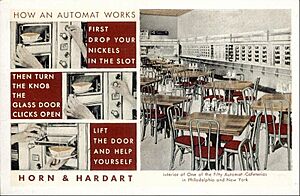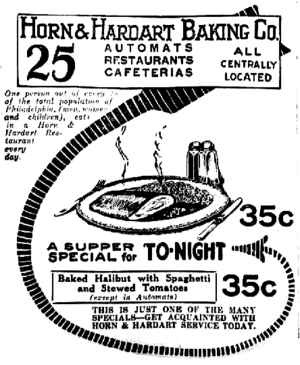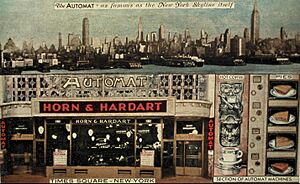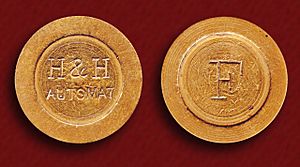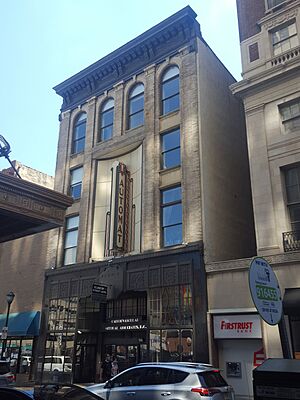- This page was last modified on 17 October 2025, at 10:18. Suggest an edit.
Horn & Hardart facts for kids
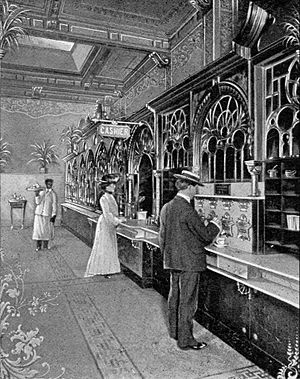
First Automat, 818-820 Chestnut Street, Philadelphia, (1904 postcard)
|
|
| Privately held company | |
| Industry | Restaurants |
| Founded | 1888 |
|
Key people
|
Joseph Horn, Frank Hardart |
| Revenue | USD |
| USD | |
Horn & Hardart was a famous restaurant company in the United States. It was known for opening the very first "automat" restaurants. These special restaurants were found in cities like Baltimore, Philadelphia, and New York City.
Joseph Horn (from Philadelphia) and Frank Hardart (from Germany, raised in New Orleans) started their first restaurant together. It opened on December 22, 1888, in Philadelphia. This small lunchroom was only about 11 by 17 feet. It had no tables, just a counter with 15 stools.
They became popular by serving New Orleans-style coffee. This coffee was mixed with chicory and called their "gilt-edge" brew. People loved the coffee, and their business grew quickly. In 1898, they officially became a company called the Horn & Hardart Baking Company.
Contents
History of the Automat
Horn & Hardart got an idea from special restaurants in Berlin, Germany, called Automat Restaurants. They were among the first companies outside Europe to get special vending machines. These machines came from a factory in Berlin that also made the first chocolate bar vending machine.
The very first automat in the U.S. opened on June 12, 1902. It was in Philadelphia. Ten years later, the first New York Automat opened in Times Square on July 2, 1912. Another one opened soon after near Union Square, Manhattan.
In 1924, Horn & Hardart started selling their popular automat foods in stores. They used the slogan "Less Work for Mother." This helped make "take-out" food popular, as it was like a home-cooked meal without the effort.
The Horn & Hardart Automats were very popular during the Great Depression. This was a time when many people had little money. Foods like their macaroni and cheese, baked beans, and creamed spinach were common and affordable meals. In the 1930s, some disagreements between worker groups led to damage at the restaurants.
By 1941, when Joseph Horn passed away, the company had 157 stores and restaurants. They were in Baltimore, Philadelphia, and New York. They served about 500,000 customers every day! In the 1940s and 1950s, more than 50 Horn & Hardart restaurants in New York served 350,000 people daily.
In 1953, the company split into two separate businesses. One was for New York and the other for Philadelphia.
How Automats Worked
In their best years, Horn & Hardart restaurants were busy and well-liked. Their automats had prepared foods behind small glass windows. You would put coins or special tokens into a slot. Then, you would turn a knob, and the glass door would open. You could then take out your food!
Workers behind the vending wall would quickly refill the empty spots. They would put in fresh items like buns, beans, fish cakes, and coffee. Even in the 1950s, you could get a full meal for less than a dollar. Later, they also served lunch and dinner meals. These included beef stew and Salisbury steak with mashed potatoes. These self-service restaurants operated for almost 90 years, from 1902 to 1991.
A writer named Carolyn Hughes Crowley described the automats. She said that large halls had shiny tables. Women in glass booths would give customers the five-cent coins needed for the machines. When a customer took food, a worker quickly put another item into the empty spot.
Promotions and Entertainment
The Horn and Hardart Children's Hour
Radio Program
Starting in 1927, Horn & Hardart sponsored a radio show. It was called The Horn and Hardart Children's Hour. This was a variety show that featured talented children. Some of these children later became famous adults, like Bernadette Peters and Frankie Avalon. The show first aired in Philadelphia. Later, it was broadcast on NBC Radio in New York during the 1940s and 1950s.
Television Program
The television version of The Horn & Hardart Children's Hour first appeared in Philadelphia in 1948. It then came to New York in 1949. It was shown on Sunday mornings.
Decline of the Automats

Automat at 104 West 57th Street near Sixth Avenue showing areas for drinks and pies
The restaurants stayed popular into the 1960s. They had automats, sit-down restaurants, cafeterias, and bakeries. But in the late 1960s, things started to change. Fast food restaurants began to appear, offering quick meals over a counter. This was a different way of eating that became very popular.
By the mid-1970s, some Horn & Hardart automat locations were replaced by Burger King restaurants. Horn & Hardart also bought other fast food chains, like Bojangles' Famous Chicken n' Biscuits, which they later sold.
The very last Horn & Hardart Automat in New York closed in April 1991. After that, the company changed its name to Hanover Direct in 1993. It then focused on selling things through catalogs.
Attempts to Revive the Brand
In 1987, Horn & Hardart tried opening two new restaurants in New York. They were called Dine-O-Mat and had a 1950s theme. However, they closed in less than two years.
In the early 1990s, some people bought the Philadelphia Horn & Hardart company. They didn't open new restaurants. Instead, they started making and selling some of the most famous automat foods in supermarkets. These included macaroni and cheese and tapioca pudding. These foods were available until 2002.
The Horn & Hardart name was also used for a chain of coffee shops in Pennsylvania and New Jersey. The last of these coffee shops closed in 2005.
As of 2016, there is a coffee shop in Philadelphia called Horn & Hardart – Bakery Cafe. Also, a company called Horn & Hardart Coffee started selling coffee online in 2016. They offer a subscription service called The Automat Club.
In Popular Culture
Horn & Hardart has appeared in many books, movies, and shows!
Literature
- In Paul Auster's 2017 book 4 3 2 1, a character visits the restaurant. It is described as a place of "twentieth-century American efficiency in its craziest, most delightful incarnation."
Museum Exhibits
- On June 22, 2012, the New York Public Library opened an exhibit called "Lunch Hour NYC." It looked at over a century of lunches in New York. The exhibit included a fully restored wall of Automat windows.
- The National Museum of American History (part of the Smithsonian Institution) used to have a large, fancy section of an Automat on display. This section came from the first Philadelphia Horn & Hardart that opened in 1902. In 2006, the business records of Horn & Hardart were given to the Smithsonian Archives.
Music
- Concerto for Horn and Hardart is a funny classical music piece. It was written by Peter Schickele, who pretended it was by a made-up composer named P.D.Q. Bach.
Stage Productions
- In the song "Colored Spade" from the musical Hair (1967), a character jokes about being a "Table cleaner at Horn & Hardart."
- The stage set for the musical The Producers (2001) included parts of an Automat.
Television
- Jack Benny, a famous comedian, held a party at the New York City Automat in 1950. It was to celebrate his new TV show. He gave each guest a roll of nickels so they could get their own food from the machines!
Film
- In the 1962 movie That Touch Of Mink, a character visits a New York City Automat.
- The Automat is a 2021 documentary film about these popular restaurants. It features famous people like Mel Brooks and Carl Reiner.

